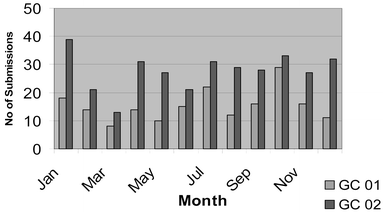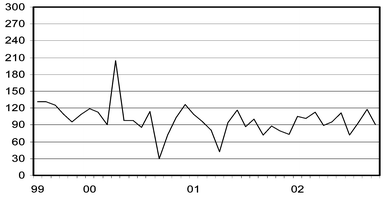Looking forward to 2003
Phenomenal growth, but technology keeps Green Chemistry at the cutting edge
Looking forward to 2003
In the recent International Assessment of University Research in Chemistry in the UK, Green and Sustainable Chemistry was highlighted as a “far reaching opportunity for chemistry” and one where “active involvement of chemistry in environmental and sustainable technologies is crucially important societally” (see http://www.epsrc.ac.uk)
The assessment was carried out by an international panel of experts and it is pleasing to see yet another endorsement of the importance of applying the principles of green chemistry to all aspects of the chemical sciences. The panel also noted that the establishment of the journal Green Chemistry by the RSC was a useful step. We can be justifiably proud of the recognition of this journal which was also evident in the excellent 2002 impact factor of 2.6 and a large increase in the number of manuscripts received (more than double that in 2000).
The panel also noted the good work of the UK’s main green chemistry networking and technology transfer organisation, the Green Chemistry Network (GCN) (http://www.chemsoc.org/gcn) and the CRYSTAL Faraday partnership (http://www.crystal.org) respectively. The success of these organisations is a further indication of the progress we have made in the years since the pioneering work of Joe Breen and Paul Anastas set the scene for the green chemistry revolution. Much of the good work in green chemistry started with the establishment of the Green Chemistry Institute (GCI) in the USA in 1997. The GCI is now a partnership with the American Chemical Society with the goal of “working today to prevent pollution tomorrow through chemistry research and education”. The GCI is now under the directorship of Dr Dennis Hjeresen and we hope to publish an update on their activities in a later issue.
The GCI and the GCN have organised and supported several successful green chemistry related symposia in recent years and a highlight of 2003 will be the first international conference on green and sustainable chemistry organised by their sister organisation in Japan, the Green and Sustainable Chemistry Network. This major event is being run in co-operation with a number of organisations around the world including the GCI, the GCN and the Centre for Green Chemistry in Australia. We can look forward to reading papers from this conference in this journal.
We have made progress in the five years since Joe Breen set up the GCI but we cannot afford to be complacent! As the international assessment panel has pointed out “…there is no country that can be said to have a broad, vigorous community in academic chemistry that is focussed on management and reduction of pollution and waste.” It is vital that we engage some of the most able academic research groups. It is equally important their efforts are integrated through multidisciplinary and collaborative research involving multiple departments and universities as well as across national boundaries. We intend to promote this in Green Chemistry through the publication of the highest quality research including the work of multidisciplinary and multi-organisational groups.
I wish you all a prosperous and successful 2003 and I look forward to seeing a continued increase in the quality and quantity of articles submitted to Green Chemistry.
Scientific Editor,Green Chemistry
James Clark
York
Phenomenal growth, but technology keeps Green Chemistry at the cutting edge
Green Chemistry enters its fifth year of publication, with confidence in the science it is currently publishing and optimism for even better quality material in the future. The number of articles received in 2002 was a new all-time high (Fig. 1), and the journal continues to grow in size. All issues in 2002 were the maximum size this type of binding would allow, thus in 2003 Green Chemistry will have a spine allowing greater flexibility. However, this increase in size has not been allowed to affect our impressively quick publication times which still average less than four months from receipt (Fig. 2). | ||
| Fig. 1 Green Chemistry submissions 2002 vs. 2001. | ||
 | ||
| Fig. 2 Green Chemistry receipt to publication times (t(50%)/days). | ||
I would like to express my thanks to all Green Chemistry Board Members on both the Editorial and Advisory Boards as they play a crucial role in promoting Green Chemistry across the globe, in supptimerorting the journal with high quality submissions from their own groups, and in the refereeing and adjudication of articles submitted by others. There are a number of developments, some new, which Green Chemistry readers should be aware of as follows:
1. Electronic publishing continues to grow in impact, and Green Chemistry continues to be at the forefront of such developments. Electronic files of papers can now be uploaded directly onto our web site at www.rsc.org/submissions.
2. Abstracts of all Green Chemistry papers have been freely available on the web since mid-2002 and access to online Green Chemistry papers is now free to all just two years after publication.
3. E-mail alerts now include direct links to articles—please sign up at http://www.rsc.org/is/journals/current /ej_update_form.htm to take advantage of this service.
4. Access to the electronic form of any RSC print journal comes free with a 2003 institutional subscription, while those institutional subscribers who wish to receive just the electronic version can now subscribe and save 10%. One institutional print subscription, or online-only subscription, allows site-wide access to the electronic version of that journal at no further cost.
5. Users of RSC journals online can now benefit from a new Reference Linking facility. This citation linking backbone is a collaborative reference linking service that allows a user to click on a citation and be taken directly to the target content. Facilities include: free access to the Chemical Abstracts Service abstract for the reference via ChemPort (http://www.chemport.org) and links to the full text of the reference, where available online, on the publisher’s server (a subscription or pay-per-view may be required to access the article), via CrossRef. Future enhancements will include a mechanism to purchase a printed copy of the cited article via the RSC Library and Information Centre’s Document Delivery Service and links to other resources.
6. Where a primary article contains chemical biology, it will be available free of charge for one month following publication in an issue through the Chemical Biology Virtual Journal (www.rsc.org/chemicalbiology). This provides an easy-to-use point of access to chemical biology literature in all RSC publications.
Finally, I would like to express my sincere thanks and gratitude to everyone who has reviewed material for Green Chemistry in 2002 and responded so magnificently to allow us to maintain the fastest publication times in this sector. The reputation of the journal and, ultimately its success or failure is dependent on the reports provided by dedicated reviewers. Thus, their input cannot be underestimated. We continue to expand our database of reviewers and hope to lighten the load, a little, for many reviewers in 2003.
As always, Editorial Board members and staff welcome suggestions as to how the journal might be improved or enhanced further. I wish you all every success in 2003.
Managing Editor,Green Chemistry
Harp Minhas
| This journal is © The Royal Society of Chemistry 2003 |
